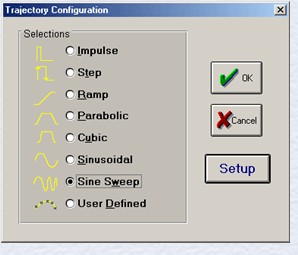| | |
 The Command menu provides for efficient specification of command trajectories and disturbance inputs and gives the interface for executing system maneuvers. Trajectories are quickly specified from a library of 7 geometric and sinusoidal forms. These allow the user to efficiently characterize the transient and frequency responses of the system. Students use these inputs to witness the change in time and frequency domain behavior caused by varying the plant parameters and control type and/or gains.
The Command menu provides for efficient specification of command trajectories and disturbance inputs and gives the interface for executing system maneuvers. Trajectories are quickly specified from a library of 7 geometric and sinusoidal forms. These allow the user to efficiently characterize the transient and frequency responses of the system. Students use these inputs to witness the change in time and frequency domain behavior caused by varying the plant parameters and control type and/or gains.
Each trajectory form is adjustable in terms of its geometric parameters, frequencies (where applicable), dwell times, number of repetitions, etc., thereby providing a virtually infinite number of possible shapes. Additionally, the user may specify a general shape with point-by-point following or auto-smoothing options. This feature is useful in the study of optimal trajectory following (least time, least power, etc.), input/output system identification, and stochastic signal transmission. The Command menu also provides for specification of disturbances at the plant output. (The disturbance drive is standard on the Model 220 system and is an option on Models 205 & 210). The user may specify a family of step, sinusoid (time or spatially dependent), or user-defined disturbance shapes in a manner similar to the input trajectories. The disturbance drive is used to vividly demonstrate the fundamental role of feedback control in rejecting disturbances of various frequencies and at various output locations. In addition, a programmable viscous friction may be introduced via the disturbance drive. | |